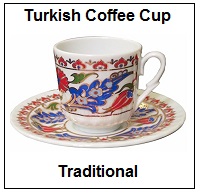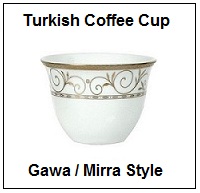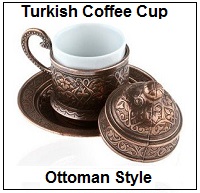Turkish Coffee Cups – Comprehensive Information
Turkish coffee cups (called “fincan”) are a necessity for serving Turkish coffee. Their purpose is to let people enjoying a strong coffee in small quantity.
 The Turkish coffee serving cup (a lot of times referred as demitasse cup) must have all the properties that are needed to keep the beverage hot for a long period of time. That’s why the espresso cups are not always the right choice.
The Turkish coffee serving cup (a lot of times referred as demitasse cup) must have all the properties that are needed to keep the beverage hot for a long period of time. That’s why the espresso cups are not always the right choice.
Turkish coffee has a higher temperature than espresso due to its making method (almost boiling level).
On the other hand people drink espresso as a shot in coffee bars. Turkish coffee’s purpose though is to last for a long time over endless conversations!
Turkish coffee cups have the correct thickness of porcelain in order to perform the best serving task. They can hold steady high temperature for the time needed for the grounds to settle down. Then they keep the beverage hot for certain time.
As it stated in all of my recipes that I present in this site (Turkish, Greek and Israeli), preheating cups is not in the practices of this method. The drinking beverage will exceed the normal temperature which is suitable for sipping and enjoying coffee. Turkish coffee cups look like espresso cups but their unique characteristics categorize them in a different tableware group.
Turkish coffee cups are an integral and important part of the Turkish coffee ritual. Alongside with the must have unique brewing pot and maybe a Turkish mill will constitute a complete set of utensils needed for making and presenting Turkish coffee.
Not to mention that without them you will never be able to see your fortune in the grounds that are left at the bottom.
Turkish Coffee Cups Historical Path
 The historical path of Turkish coffee cups can be traced in the 19th century. France introduced them to its people under the name of “demitasse cup” (half cup).
The historical path of Turkish coffee cups can be traced in the 19th century. France introduced them to its people under the name of “demitasse cup” (half cup).
These new cups were the half size of a typical tea cup of that time. It could hold 2-3 fl. oz. / 60-90 ml of liquid. They have a height of 2-2.5 in. / 5-6 cm. They were accompanied by saucers (“coffee stands”) which had a diameter of 4-4.5 in. / 10-12 cm.
In its early stages people were serving Turkish coffee in different shape/ material “cups”.
Metal cylinder cans with a handle and clay cups were the most favorable. Another Ottoman style cup was the one that had a metal frame. They put a glass or ceramic cup inside .
In 1850 porcelain and bone china replaced the old materials. A new era of Turkish coffee cups production began. A variety of forms with handmade artistic designs flourished in Turkey.
Turkish Coffee Cup Size
The size of a Turkish coffee cup has changed through its long history. It appeared as a tiny cup and in a few occasions it became very huge (“kallavi”).
Nowadays, the most standard size is the Turkish coffee cup. It can hold 2-2.5 fl. oz. / 60-75 ml. of liquid.
Some manufacturers tend to show varieties of 2.5-3 fl. oz / 80-100 ml. as espresso / Turkish coffee cups. But are not suitable for the correct serving of Turkish coffee.
The saying “more is merrier” doesn’t apply here.
Common Types of Turkish Coffee Cups
The demitasse cup with handle is the most common and popular Turkish coffee cup type. A few more varieties though exist and have their own clientele of tradition lovers.
Two of them are:
 (1) The “no handle” Turkish coffee cups (also known as “Gawa” or “Mirra” in Arabic).
(1) The “no handle” Turkish coffee cups (also known as “Gawa” or “Mirra” in Arabic).
They used to be the traditional Turkish coffee cups of the past. The cup was hold carefully by someone’s fingertips while sipping the coffee.
 (2) The filigree or jeweled metal holders with a porcelain or glass cup put into them.
(2) The filigree or jeweled metal holders with a porcelain or glass cup put into them.
You can also find these cups with the name “Ottoman”. You will may hear another name in for this metal basket; “zarf”.
Its purpose is to protect the drinker’s fingers from burning.
They make them with nickel-plated copper, tinned copper, silver or gold. Most of them have exclusive motifs, gems and other precious ornaments.
Some of them are art pieces. Very popular during Ottoman times but nowadays are serving mostly “special persons”.
Turkish Porcelain Regions and Manufacturers
Kütahya is the porcelain and ceramic capital of Turkey. It is very famous for its persistence of the Cini earthenware style once flourished in Iznik.
During the 15th and 16th century Iznik was the main producer of high quality ceramics in Turkey.
For economic reasons the production declined. Slowly-slowly closed down. Kütahya took over the production in the mid of the 20th century.
Turkish Ministry of Culture and Tourism published an interesting article explaining in details the usage of clay in traditional arts.
The most known manufacturers of the region are:
- Kütahya Porselen
- Güral Porselen
Established in 1973. It is one of the biggest companies worldwide in ceramic production. The company focuses on high quality handcrafted ceramic production. Kütahya operates domestically (more than 40 shops in mainland) and abroad by exporting a lot of its production.
Established in 1989. It’s a major producer of porcelain tableware and exports to many countries. Güral combines craftsmanship and high technology. Customers worldwide recognize the firm for creativity in designs as well as its marketing policies.
Both names guarantee excellent Turkish coffee cups. They are indeed the representatives of Turkish tradition in an applied artwork of great quality and workmanship.
Watch the following video to learn the importance of Iznik Cini (tiles) in the Turkish culture. They influenced the designs on Turkish coffee cups.
Turkish Coffee Cups Buying Criteria
Before you invest in Turkish coffee cups put down some buying criteria to follow. They will save you money and will lead you to the best suitable choice.
Find some of the available choices in online stores.
 |
 |
 |
 |
Turkish coffee cups are unique coffee utensils for making Turkish coffee. They play a significant part in the presentation of the coffee. Four initial criteria should be:
- Purpose (Daily use or special occasions)
- Needed quantity (Singles or Sets)
- Price (Low-Mediocre-High)
- Design (Shape of the cups as well motifs on them)
If you would move a step forward then you might also take into account some parameters. Country of origin, manufacturer, porcelain quality and culture-tradition are a few of them.
For daily usage try something simple and not too expensive. If you buy a set check if they have the item in singles as well. It’s a good practice in case you want a replacement.
For special occasions you should choose a set that represents mostly your personality. Look for Turkish coffee cup sets with workmanship and culture expression.
Turkish Coffee Cups Cleaning Tips
Cleaning the Turkish coffee cups is the final step of the trip to mastering this coffee making method. The target now is to protect their polishing and design.
Tip #1. Wash them by hand, using neutral-aroma detergents (best without any scent) and warm (not HOT) water. Then rinse them with a lot of cold water.
Tip #2. Dry them either by letting them upside down on a towel or by rubbing them with soft cotton cloth.
Tip #3. DO NOT place Turkish coffee cups in a dishwasher. There is a possibility to ruin the existing designs or for the plain ones to diminish their sparkling appearance.

